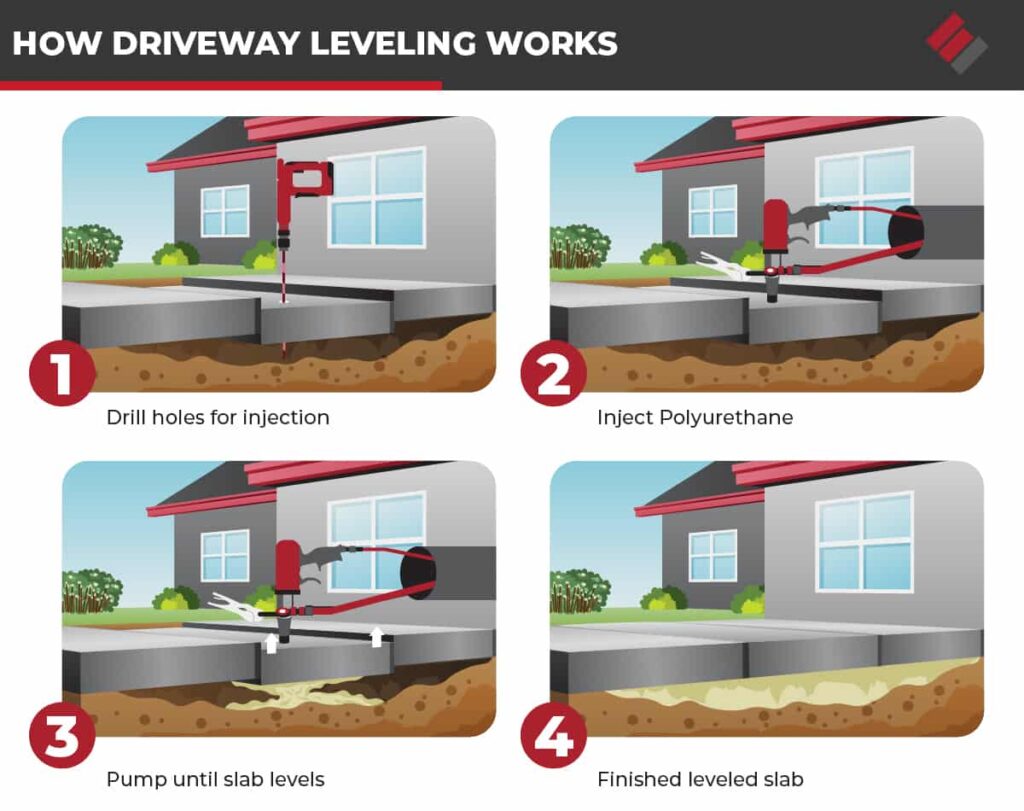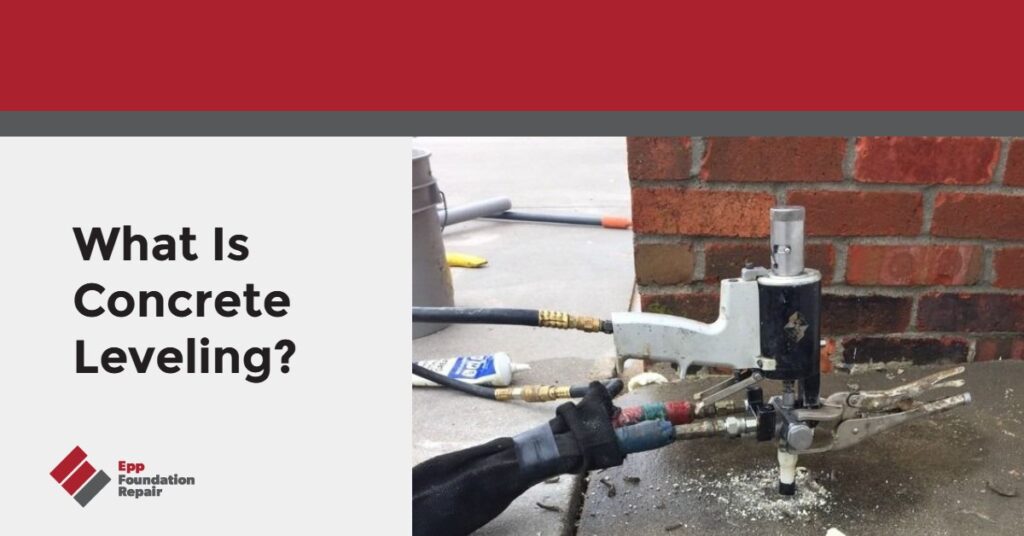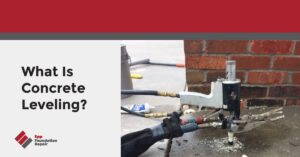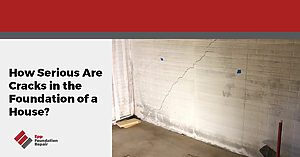Are you looking for information about concrete leveling? If so, this short article has what you need. We’re going to talk about what concrete leveling is, what causes uneven concrete slabs, the concrete leveling procedure, and more.
Uneven slabs are a trip hazard and a liability. If someone trips and gets injured, you could find yourself facing an unpleasant lawsuit. Fortunately, concrete leveling can be completed in just a few hours.
What Is Concrete Leveling?
Concrete leveling is a method for repairing an uneven slab – such as a sidewalk, driveway, patio, etc. – without digging up the old slab and pouring a new one. While tearing up the uneven slab and pouring fresh concrete is an expensive and time-consuming process, most concrete leveling jobs can be completed in just a few hours, and then the slab is ready for use again.

Types Of Concrete Leveling
Mudjacking
Traditionally, concrete leveling was done via a procedure called “mudjacking,” which used a cement slurry to lift and level the uneven slab. The mudjacking slurry is a mix of soil, sand, cement, and water. It looks like mud, hence the term “mudjacking.” While mudjacking is still being used today, it’s not as popular as it once was.
The mudjacking procedure is as follows:
- 1-2 inch holes are drilled in the slab you want to lift
- The cement slurry is injected under the slab via the holes
- The slurry fills any voids and raises and levels the slab
- The holes are patched with a compound that matches the color of the concrete
Here at Epp Foundation Repair, we don’t use mudjacking because it’s a messy procedure, the slurry isn’t resistant to erosion, and the holes required for the slurry are larger than those necessary for polyurethane foam injection. There’s also some downtime while you wait for the cement slurry to dry and harden.
Polyurethane Foam Injection
Instead of a cement slurry, polyurethane foam injection uses a synthetic, waterproof material to lift and level the slab. Today, concrete leveling foam is the most common way to perform concrete leveling.
The polyurethane foam injection procedure is as follows:
- Dime-sized holes are drilled in the slab you want to be lifted and leveled
- The concrete leveling foam is injected under the slab via the holes. (The foam consists of two parts that are combined in the nozzle.)
- In a few seconds, the foam begins to expand and fill any voids under the slab. This lifts and levels the slab.
- The holes are patched with a compound that matches the concrete.
Most concrete leveling jobs using concrete leveling foam are completed within a few hours, and then the slab is ready for use again. There’s no downtime.
For more information, see Concrete Lifting Foam Beats Mudjacking Hands Down For Fixing Uneven Slabs.
What Causes Concrete To Become Uneven?
Concrete slabs become uneven for various reasons including, but not limited to:
- Soil erosion under the slab – Soil prone to erosion can wash away, creating voids under the slab. If the slab sinks into the voids, it will become uneven.
- Expansive soil – Expansive soil is soil with a lot of clay. Because of this, it expands when it soaks up moisture and shrinks when it releases moisture and dries out. This swelling-shrinking cycle creates movement under the slab than can cause it to become uneven.
- Soil that wasn’t compacted enough before construction started – Soil needs to be tamped down before a concrete slab is poured on top of it. If this isn’t done correctly, the slab will settle into the soil after it’s poured and become uneven.
- Tree roots – We’ve all seen examples of invasive tree roots pushing up on a concrete sidewalk. However, tree roots can also “drink” water from the soil under the slab leaving behind voids that could lead to an unlevel slab.
- Drought – If the soil under the slab dries out, it could cause the slab to become uneven.
- Earthquakes – We probably don’t need to explain how this works.
How Much Does Concrete Leveling Cost?
The cost of concrete leveling depends on…
- Your geographical location
- The size of the slab that needs leveling. The bigger the slab, the more polyurethane foam is required.
- Ease of access to the slab also plays a role in the cost of concrete leveling.
Because of these factors, we can’t tell you how much it will cost to raise a slab unless we first perform an inspection. Therefore, you’ll need to contact a foundation repair contractor near you with experience leveling uneven concrete and ask for an inspection and repair estimate.
We can tell you this, though…
Concrete leveling is less expensive and faster than digging up and replacing the slab. Only when a concrete slab is extremely damaged is concrete leveling not an option.
If you have an uneven slab on your property – business or residential – that needs concrete leveling and you’re in our service area in Nebraska, Iowa, Kansas, or Missouri, contact us today. We’ll come out for an inspection and give you a repair estimate.







